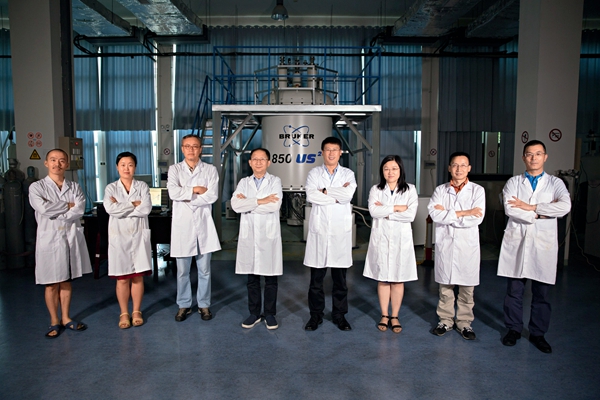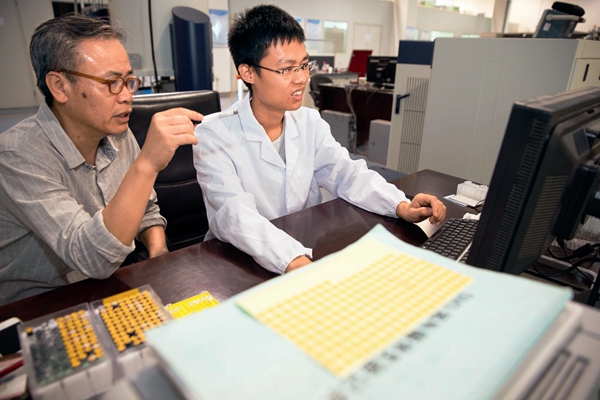By YE LEFENG
By YE LEFENG
SCIENCE Island, as it is known, is a 2.65-sq-km peninsula in the midst of the Dongpu Reservoir in northwest Hefei, capital of Anhui Province, and is the site of the Hefei Institute of Physical Science of the Chinese Academy of Sciences (CAS) and its 10 subordinate research institutes.
The star attraction of Science Island for the 2,400 top researchers from around the world who have come here is its “artificial sun,” or tokamak, an all-superconducting non-circular section nuclear fusion experiment facility that holds hydrogen plasma hotter than the core of the sun.

No less groundbreaking is the island’s Steady High Magnetic Field Facility (SHMFF). High magnetic fields, like extremely low temperature and ultrahigh pressure, provide the extreme experimental environment vital for scientific research, and are consequently invaluable for scientific explorations. The results of 19 international magnetic field-related research projects have won Nobel Prizes since 1913. The SHMFF was installed on Science Island in May 2008, and has gradually become a world-class high magnetic field science center.
Eight post-doctoral fellows of Harvard Medical School have come to Science Island since 2009. They have been drawn by its state-of-the-art research facilities, and an environment conducive to fulfilling their scientific dreams. All have achieved success in their scientific endeavors.
Seizing the Opportunity
Wang Junfeng was the first to return to China. He obtained his master’s degree from Peking University in 1995, and started his postdoctoral research in the Harvard Medical School Department of Biochemistry and Molecular Pharmacology in 2004. Having published many articles in Nature and other top journals, his scientific research achieved wide recognition.
As a specialist in research on nuclear magnetic resonance and structural biology, Wang is cognizant of the significance of strong magnetic field devices. Upon completion, the 40-tesla steady-state magnetic field would be one of the world’s foremost, and integral to his research. Meanwhile, the Hefei Institutes of Physical Science made the commitment to put Wang in charge of building and heading the Magnetic Resonance Life Science Department of CAS High Magnetic Field Center. It was this rare opportunity that prompted Wang Junfeng to come to the island with his family in 2009.
At first, the center lacked certain key experimental apparatus and equipment. Wang had to take experimental samples, and scoured the country for equipment suitable for carrying out experiments.

One year later, the buildings comprising the SHMFF were completed, and a wide range of experimental facilities were successfully set up. But Wang still had to resolve the most important matter of finding the life science talents needed to work and pursue their research there.
His thoughts naturally turned to seven of his former peers from Harvard Medical School.
No Place Like Home
Wang’s return had a fortuitous effect on the lives of Liu Qingsong and his wife Liu Jing, who had already decided to go back to China. After living in the U.S. for more than a decade, Liu Qingsong still felt like a piece of duckweed floating on water, with no sense of belonging.
Liu Qingsong visited Wang during a business trip to Shanghai in 2010, and Wang invited the couple to work on the island. Liu, who had been involved in research and development of anti-tumor drugs, was attracted to the island’s “blank slate” regarding its life science and pharmaceutical research.
After inspecting the island’s facilities, Liu was impressed with their interdisciplinarity, as evidenced in their specialization in chemistry, material science, and physics, all of which are vital to his pharmaceutical research. Harvard Medical School did not have such conditions, least of all an SHMFF.
What had moved Liu most was meeting with Kuang Guangli, head of the Party committee of the Hefei Institutions. Kuang had returned to China at 32 after studying in Germany to pursue his research on the island. At that time Liu Qingsong was also 32, and he then made the decision to join the island’s scientific community. When he discussed this idea with his wife, she raised no objections, trusting his reasons for making this choice.
To locate more life science researchers, Liu Qingsong was given independent recruitment rights. The first candidate he thought of was Zhang Na, a specialist in nucleic acid. Born in Beijing, Zhang obtained his master’s and doctoral degrees in the United States, between the years 1996 and 2005, when he started his postdoctoral research at the Harvard Medical School. However, the longer he spent abroad, the more he yearned to return to China. “My interest was aroused when Liu told me about the island’s SHMFF,” Zhang said. Although there was a considerable disparity between his income in the U.S. and in China, Zhang nevertheless came to Science Island in 2012.
“There was no SHMFF in Beijing, this was what drew me to the island,” Zhang said.
Lin Wenchu came to Science Island in 2013. Born in Hubei Province, Lin started his postdoctoral research work using animal models for the genetic regulation of cancer at Harvard Medical School in 2007. Upon receiving Liu’s invitation, he accepted without hesitation. “I have long dreamed of the opportunity to establish my own independent laboratories – something that would have been impossible in the U.S., where I was always working for other people,” Lin said.
Wang Wenchao and his wife Zhang Xin took longer to yield to Liu’s persuasion than Zhang Na and Lin Wenchu. Their son and daughter were born in the U.S., they had a stable life, and their research was going smoothly. “My daughter was happy in her environment, and I could see she would find it difficult to adapt to a new life in China,” Zhang Xin said. Her decision to return was prompted by an international student gathering where each child held his or her national flag. But China’s Five-Star Red Flag meant nothing to her daughter. This upset Zhang. “Our child had been completely westernized. When we spoke to her in Chinese, she replied in English. This seemed wrong to me.” In 2012, therefore, the couple concluded their research at the Harvard Medical School and came to Science Island with their two children.
Personal Values vs Serving the Country
As a specialist in high throughput screening technology in drug research, Ren Tao kept in contact with old friends while conducting his postdoctoral research at the Harvard Medical School. He shared the pleasure of their achievements.
In 2015, after completing his project, he went to Science Island. Ren Tao’s presence made the “Harvard team” all the more stronger.
An SHMFF-based, major disease-oriented interdisciplinary research academic chain has since been completed.
Inevitably, certain scientific research conditions in the newly-built SHMFF were somewhat preliminary. Compared with the equipment that members of the life sciences team had used in previous scientific research, not including the SHMMF, the facilities available fell far short of international leading standards.
However, the scientists received support, in the form of capital, projects, and personnel, through various national and local policies geared to nurturing talent. Liu Qingsong observed that the historical backdrop today has changed from that where the older generation of returnees, such as Qian Xuesen and Li Siguang, were needed by the motherland. Today, the situation has dramatically changed for Liu and his team. Achieving individual value is thus consistent with serving the home country.
Peaceful Science Island is far from the urban hustle and bustle, and hence an ideal setting for research. Life here is also convenient. Wang Wenchao and Zhang Xin’s children go to the nearby school, and they are delighted with their daughter’s progress in Chinese language. “At first she couldn’t understand a word on the Chinese exam paper, but now her Chinese has reached middle level in the class,” Zhang Xin said.
World-class Scientific Payoffs Achieved
Liu Qingsong and his wife Liu Jing, along with Wang Wenchao and Ren Tao, have formed a pharmaceutical team that conducts antitumor drug research and precision medicine applications. When it came to the development of new drugs, many of Liu Qingsong’s peers told him, “The period of new drug development is long, and does not necessarily guarantee successful results, so it’s better to widen your research options and publish research papers.” However, Liu Qingsong has resolved to stay true to his original intent. He aims to work towards the development of new drugs that can help cancer patients’ survival and improve their quality of life, through controlling the cancer in the same way as a chronic disease.
After five years, the team has built the world’s largest high-throughput cell library focusing on cancer kinase targets in 2015.
Furthermore, to ensure that “the patient takes the right drug at the right time,” these scientists independently developed the first domestic precision tumor treatment technology system. They have thus integrated high-throughput invitro drug sensitivity test technology with high-throughput targeted gene sequencing technology. This not only maximally screens the most available drugs for cancer patients, but also provides reference solutions for doctors.
One of Liu’s American friends recently paid a visit to the island. Observing that he leads a 50-member interdisciplinary research and development team, and has first-class resources for research, his friend remarked, “This is incredible, and highly unlikely in the United States!”
Relying on the core technology of the pharmaceutical team and support of CAS and the local government, the Hefei PreceDo Pharmaceuticals Ltd. has been established, and has so far provided precision medical services to thousands of cancer patients. “In recent years, state incentives for researchers have improved greatly, whereby our research contributions can be converted into shares. Through stock ownership incentives, the government supports us with real money,” Ren Tao said. “Thanks to the strategy of mass entrepreneurship and innovation, large numbers of venture companies have been seeking to cooperate with us since 2015.”
Last February, the hybrid magnetic technology of the CAS High Magnetic Field Science Center passed the state inspection. The 40-tesla steady-state magnetic field ranks world second in terms of magnetic field intensity, which took the scientists eight years to achieve from scratch. “Our next step is to make the world’s No. 1 steady-state magnetic field,” Kuang Guangli said.
“With a good policy, a good environment, a good platform, and good benefits, there is no reason why we shouldn’t make world-class scientific research achievements,” Zhang Na said.
Every time he passes the SHMFF, Wang Junfeng feels a surge of emotion. He remembers the first day he came to Science Island and, in that then open space, spoke to Kuang Guangli about scientific research, and imagined the blueprint. Now everything he spoke about and thought of that day has come true.
YE LEFENG is a Guangming Daily reporter.